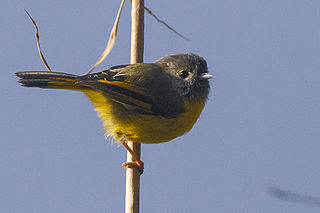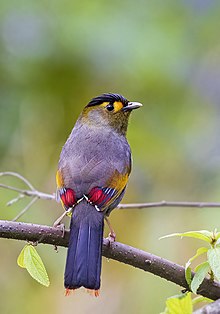The Buguns are one of the earliest recognized schedule tribe of India, majority of them, inhabiting the Singchung Sub-Division of West Kameng District of Arunachal Pradesh. Buguns live in several exogamous clans. Traditionally, the predominant occupation was agriculture, supported with other allied activities like fishing and hunting, cattle rearing etc. Buguns have their own folklores, songs, dances, music and rituals. A rare bird, the Bugun liocichla, was named after the tribe.

West Kameng is a district of Arunachal Pradesh in northeastern India. It accounts for 8.86% of the total area of the state. The name is derived from the Kameng river, a tributary of the Brahmaputra, that flows through the district.

Japalura austeniana, also known commonly as the Abor Hills agama or Annandale's dragon, is a rare species of lizard in the family Agamidae. The species is endemic to Asia.
Lycodon gammiei, commonly known as Gammie's wolf snake or the Sikkim false wolf snake, is a species of nonvenomous snake in the family Colubridae. The species is endemic to India.

The liocichlas are a group of birds in the genus of the same name, Liocichla, from the family Leiothrichidae. They are found in Asia from India to China. They belong to a clade also containing at least the Leiothrix, the barwings, the minlas and the sibias. Among these, they are an early offshoot, or basal lineage.
The Emei Shan liocichla is a passerine bird in the family Leiothrichidae. The species, also known as the Omei Shan or grey-faced liocichla, is endemic to mountain ranges in Southern Sichuan, China. It is closely related to the Bugun liocichla, a species only described in 2006, and which it closely resembles.

Eaglenest or Eagle's Nest Wildlife Sanctuary is a protected area of India in the Himalayan foothills of West Kameng District, Arunachal Pradesh. It conjoins Sessa Orchid Sanctuary to the northeast and Pakhui Tiger Reserve across the Kameng river to the east. Altitude ranges are extreme: from 500 metres (1,640 ft) to 3,250 metres (10,663 ft). It is a part of the Kameng Elephant Reserve.

The golden-breasted fulvetta is a species of songbird found in Bhutan, China, India, Myanmar, Nepal, and Vietnam. Its natural habitats are temperate forests and subtropical or tropical moist montane forests.

The ferruginous flycatcher is a species of bird in the family Muscicapidae.

The striated yuhina is a bird species in the white-eye family Zosteropidae.

Sessa Orchid Sanctuary is a 100 km2 protected area of India in the Himalayan foothills in Bhalukpong Forest Division of West Kameng District, Arunachal Pradesh. It conjoins Eaglenest Wildlife Sanctuary to the southwest. It is a part of the Kameng Protected Area Complex (KPAC), which is an Elephant Reserve. See map. The department of Environment & Forests has developed trekking routes for visitors to enjoy the natural habitats of orchids. There are deep gorges and valleys, high peaks and rugged terrain that are rewarding for nature lovers and adventure tourists. A nursery includes representative specimens of various orchid species of the sanctuary and a demonstration farm of Cymbidium hybrids for cut-flower production. Most of Sessa has traditionally been claimed by the Bugun tribe as part of their territory.
The Kameng Elephant Reserve is an Elephant Reserve located in the Himalayan foothills of Arunachal Pradesh, India, in the districts of West Kameng and East Kameng.

Ramana Athreya is a birdwatcher and an astronomer at the Indian Institute of Science Education and Research Pune. In 2006, he described a new species of bird, the Bugun liocichla from the Eaglenest Wildlife Sanctuary in western Arunachal Pradesh, North-east India. This discovery has been described by BirdLife International as the most sensational ornithological discovery in India for more than half a century. He was awarded the Pakshishree award in 2009 for this discovery by the government of Rajasthan. In May 2011, he was conferred the Whitley Award, one of seven people awarded in the year, for his work on conservation and involving communities in Eaglenest Wildlife Sanctuary.
Pakke Tiger Reserve, is a Project Tiger reserve in the East Kameng district of Arunachal Pradesh in Northeast India. The 862 km2 (333 sq mi) reserve is protected by the Department of Environment and Forest of Arunachal Pradesh. It was known as Pakhui Tiger Reserve, but renamed in April 2001 by the Governor of Arunachal Pradesh. It has won India Biodiversity Award 2016 in the category of 'Conservation of threatened species' for its Hornbill Nest Adoption Programme.

The Department of Environment and Forests of Arunachal Pradesh (DEFAP) is a state-sponsored agency responsible for conserving the environment, identifying, establishing, and conserving protected areas in the Indian state of Arunachal Pradesh.

Arunachal Pradesh is primarily a hilly tract nestled in the foothills of the Himalayas in northeast India. It is spread over an area of 83,743 km2 (32,333 sq mi). 98% of the geographical area is land out of which 80% is forest cover; 2% is water. River systems in the region, including those from the higher Himalayas and Patkoi and Arakan Ranges, eventually drain into the Brahmaputra River.
Indian Birds is a bi-monthly ornithology journal/newsletter that was established in 2004. It was formerly published under the heading Newsletter for Ornithologists for one year. It publishes articles on identification, distribution, migration, conservation and taxonomy, apart from reports of significant ornithological sightings and events. Published from Hyderabad, the publication is owned by New Ornis Foundation.
Singchung is a census town in West Kameng district, Arunachal Pradesh, India. As per 2011 Census of India, Singchung has a total population of 14,534 people including 9260 males and 5,274 females.













